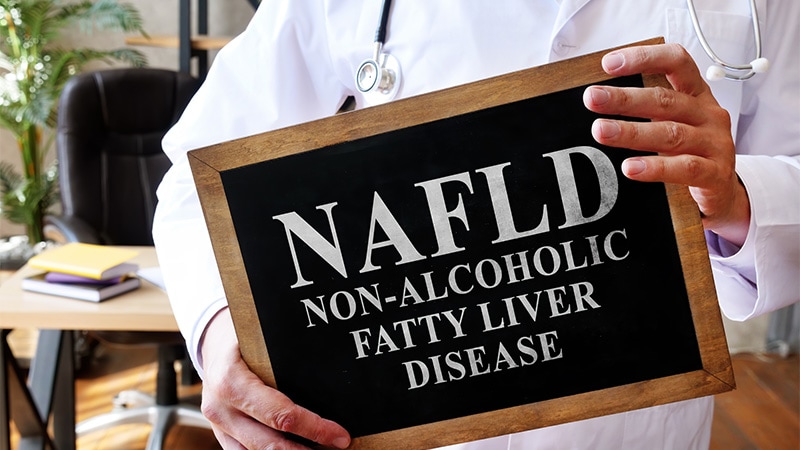
Nonalcoholic fatty liver disease (NAFLD) is an increasingly common, underdiagnosed, and underappreciated independent risk factor for atherosclerotic cardiovascular disease (ASCVD), the American Heart Association (AHA) says in the first-ever scientific statement on NAFLD and its association with heart disease.
Rates of NAFLD are rising in association with rising rates of obesity and metabolic syndrome, with 25% of adults worldwide believed to be affected.
NAFLD is often “hidden or missed in routine medical care,” P. Barton Duell, MD, chair of the statement writing group, says in a news release.
“It is important to know about the condition and treat it early because it is a risk factor for chronic liver damage and cardiovascular disease,” says Duell, from the Knight Cardiovascular Institute, Oregon Health & Science University, Portland.
Indeed, ASCVD is the principal cause of death in patients with NAFLD, the authors note.
The statement was published online April 14 in Arteriosclerosis, Thrombosis, and Vascular Biology.
It provides an overview of the underlying risk factors and pathology of NAFLD, links to ASCVD, diagnostic and screening strategies, and potential interventions.
It emphasizes the need for greater awareness and monitoring for NAFLD, access to improved screening tools and treatment, and highlights the lifestyle changes to help prevent and treat the disorder.
Hidden CVD Risk Factor
Unless specific testing is performed, NFALD typically remains silent until advanced and potentially irreversible liver damage sets in, the writing group says.
They caution that measuring alanine aminotransferase (ALT) and aspartate aminotransferase (AST) might not be helpful for diagnosing NAFLD and nonalcoholic steatohepatitis (NASH) because of poor sensitivity and specificity. AST and ALT levels can be in the normal range in patients with NAFLD, even patients with NASH, although levels can approach the upper limit of normal.
“Liver biopsy is the gold standard for diagnosis of NAFLD and NASH, but the procedure is expensive and has increased risk of complications,” the group points out.
Improved diagnostic strategies for identifying NAFLD and NASH are needed, but existing modalities, such as ultrasound-based vibration-controlled transient elastography (FibroScan), are useful for disease staging and longitudinal monitoring, although underutilized, the writing group says.
They note that most patients with hepatic steatosis do not progress to NASH, cirrhosis, or hepatocellular carcinoma, but a subgroup will.
Because it’s tough to identify which patients will have disease progression, imaging studies, possibly in combination with liver biopsy, are “essential” for monitoring disease severity and progression.
Routine liver ultrasound is useful if it shows hepatic steatosis, but it cannot quantify the extent of steatosis or rule out hepatic steatosis, the group states.
Lifestyle Intervention
They note that NAFLD occurs in association with insulin resistance (with or without diabetes), obesity (especially visceral adiposity), metabolic syndrome, and dyslipidemia. Genetic factors (monogenic or polygenic) modulate the risk for development of NAFLD and progression to NASH.
Many risk factors for NAFLD are also risk factors for ASCVD, and when assessing ASCVD risk, NAFLD can be considered a “risk enhancer,” the group advises.
They say lifestyle intervention is the “key therapeutic intervention” for patients with NAFLD. This includes dietary modification, increased physical activity, weight loss, and alcohol avoidance.
In many patients, the loss of 5% to 10% of body weight can reverse hepatic steatosis and stabilize or diminish NASH. However, this goal is often difficult to achieve.
Additional treatment goals include improved insulin sensitivity, reduced hyperglycemia, and triglyceride lowering.
“Part of the good news about managing NAFLD is that healthy eating, regular exercise, and weight loss or avoiding weight gain are all valuable interventions to improve health in most of us, regardless of whether we have NAFLD,” Duell says in the release.
Drug therapies include glucagon-like peptide 1 receptor agonists, which can “modestly” improve NAFLD in association with improved glycemia, weight loss, and reduced risk for major adverse cardiovascular events, the writing group says.
Novel experimental drug therapies that target various steps in the pathogenesis of NAFLD are currently in development, but most have modest efficacy, and toxicity is a limiting factor for some agents, the group says.
“It is hoped that with increased awareness of NAFLD, better access to reliable imaging tools for screening and monitoring for NAFLD and proven tools for the treatment of NAFLD, the rising tide of NASH and more advanced hepatic disease can be reversed and adverse ASCVD outcomes prevented,” they write.
This scientific statement was prepared by the volunteer writing group on behalf of the AHA’s Council on Atherosclerosis, Thrombosis and Vascular Biology; the Council on Hypertension; the Council on the Kidney in Cardiovascular Disease; the Council on Lifestyle and Cardiometabolic Health; and the Council on Peripheral Vascular Disease.
This research had no commercial funding. A complete list of author disclosures is available with the publication.
Arterioscler Thromb Vasc Biol. Published online April 14, 2022. Full text
Source: Read Full Article